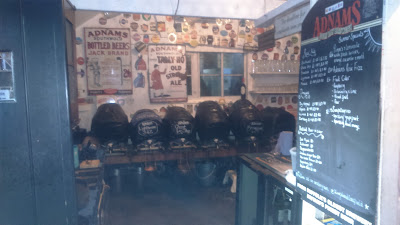I was flicking through the pages of “What’s Brewing” yesterday
morning, and a couple of things caught my eye. For the uninitiated, “What’s
Brewing” is the official newspaper of the Campaign for Real Ale. The paper can
trace its origins back to the early 1970’s, not long after CAMRA was formed.
This cleverly-named publication has seen several changes over the past 40
years, but it is still mailed out to members each month; just as it was in the
very early days of the Campaign.
The main headline in this month’s edition, and the one which
really attracted my attention, reads “Pubs key role in reduced figures for
alcohol abuse”. According to the article, research by the Local Alcohol Profile
for England,
(whoever they might be), has revealed a significant fall in the number of
hospital admissions related to harm caused by alcohol. The fall is across all
age groups and applies to both sexes.
Good news, of course, but the article then goes on to link
this fall with the findings from research group carried out by Oxford
University. This different research
concludes “Pub-goers are likely to drink less if those around then are behaving
in a measured way and are, as a result, likely to be less tolerant of socially
inappropriate behaviour”.
Nothing new there, but this is where CAMRA’s chief executive
Tim Paige, throws his hat into the ring by stating, “This is why it is
especially important we continue to support pubs across the country, to ensure
everyone has a local within easy distance of their home or workplace”.
So far, so good, but Tim then goes on to spoil things by
stating “We at CAMRA believe there should be greater acknowledgement by
government, of the distinction between those who drink in moderation in
responsibly-managed social settings, and those who abuse alcohol – most often
bought from supermarkets and drunk at home”.
I really thought CAMRA had moved beyond this, but it would
appear not, and it is back to the same old rhetoric about supermarkets selling
beer at a cheaper price than water, and unless you purchase your drink in a pub,
and consume it there under the watchful eye of the licensee, you are abusing
alcohol and are at serious risk of harm. Really???
I wrote about this very thing just over three weeks ago,
pointing out that many of us drink at home for personal, family, financial reasons
or just the plain fact that there isn’t a decent pub within walking distance. I
don’t want to go over the whole article again, but speaking from personal
experience I drink far less within the confines of my own home than I do when
I’m in the pub.
 |
| Tim Page - CAMRA CEO |
Now I had the pleasure of meeting Tim a few weeks ago, at
the “Consultation Meeting” I attended in relation to CAMRA’s
“Revitalisation Project”, and he
came across as a pretty level-headed sort of chap. I am therefore more than a
little surprised to see him coming out with such a statement; especially as it
is fundamentally flawed.
You are obviously not
listening Tim; or if you are you are only hearing what you want to hear. If
CAMRA continues down the road of alienating the large, and still growing,
section of the population who, for whatever reason prefer to drink at home, it
will be doing itself a grave disservice. Furthermore it will provide ammunition
to those lobbying for minimum pricing for alcohol - an issue which had almost
faded away, but which now seems to be rearing its ugly head once more.
Alcohol is alcohol,
and to make out that pub bought booze is somehow more virtuous than a few bottles
bought from a supermarket is akin to talking out of one’s rear end!

























